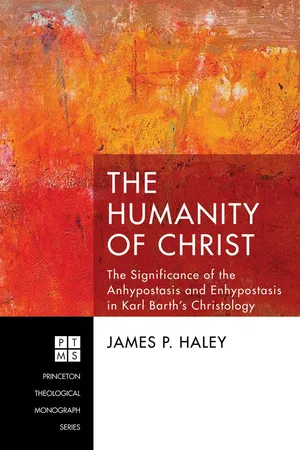
The Humanity of Christ
The Significance of the Anhypostasis and Enhypostasis in Karl Barth's Christology
- 338 pages
- English
- ePUB (mobile friendly)
- Available on iOS & Android
The Humanity of Christ
The Significance of the Anhypostasis and Enhypostasis in Karl Barth's Christology
About This Book
This work is a critical analysis of Karl Barth's unique adoption of the concepts anhypostasis and enhypostasis to explain Christ's human nature in union with the Logos, which becomes the ontological foundation that Barth uses to explain Jesus Christ as very God and very man. The significance of these concepts in Barth's Christology first emerges in the Gottingen Dogmatics and is then more fully developed throughout the Church Dogmatics. Barth's unique coupling together of anhypostasis and enhypostasis provides the ontological grounding, flexibility, and precision that so uniquely characterizes his Christology. As such, Barth expresses the Word became flesh as the revelation of God that flows out of the coalescence of Christ's human nature with his divine nature as the mediation of reconciliation. This ontological dynamic provides the impetus for Barth's critique of Chalcedon's static definition of the union of divine and human natures in Christ from which Barth transitions to an active definition of these two natures. Not only does anhypostasis and enhypostasis explain the dynamic union between the divine and human natures in Christ, but also the dynamic union between Jesus Christ and his Church, which reaches its apex in the reconciliation of humanity with God, in Christ. The ontological foundation of anhypostasis and enhypostasis in Christ's union with his Church explains the importance of the royal man in understanding genuine human nature, the exaltation of human nature, and the sanctification of human nature.
Frequently asked questions
Information
Anhypostasis and Enhypostasis
Table of contents
- Title Page
- Dedication
- Acknowledgments
- Introduction
- Chapter 1: Anhypostasis and Enhypostasis
- Chapter 2: Karl Barth’s Interpretive Construal of Anhypostasis and Enhypostasis
- Chapter 3: Anhypostasis and Enhypostasis
- Chapter 4: Anhypostasis and Enhypostasis
- Chapter 5: Barth’s Christological Method in View of Chalcedon
- Chapter 6: Beyond Chalcedon
- Conclusion
- Bibliography